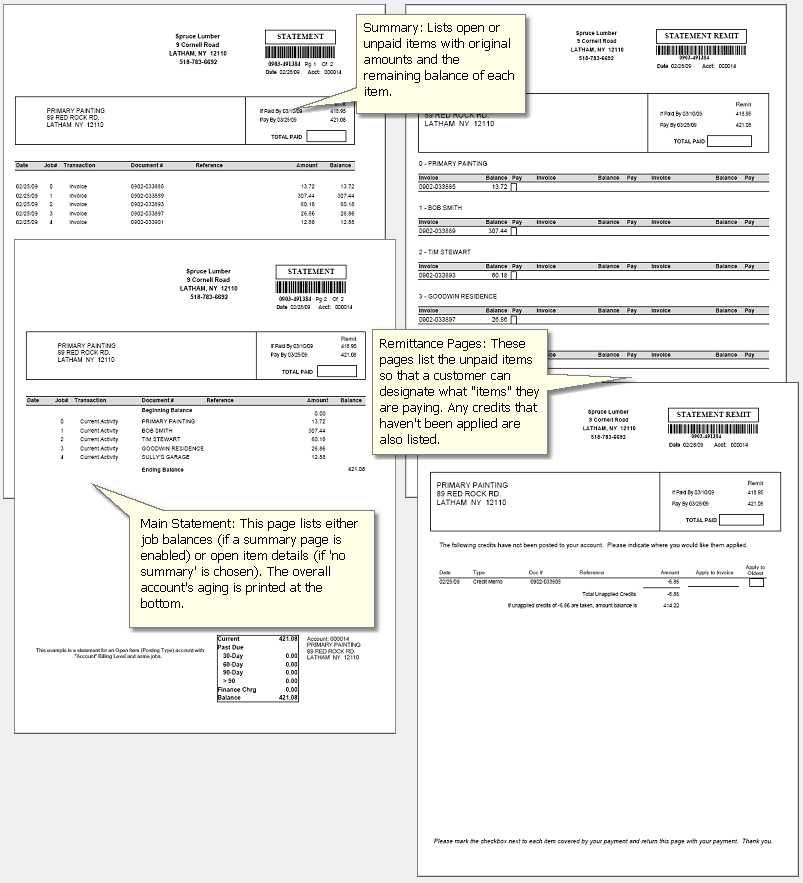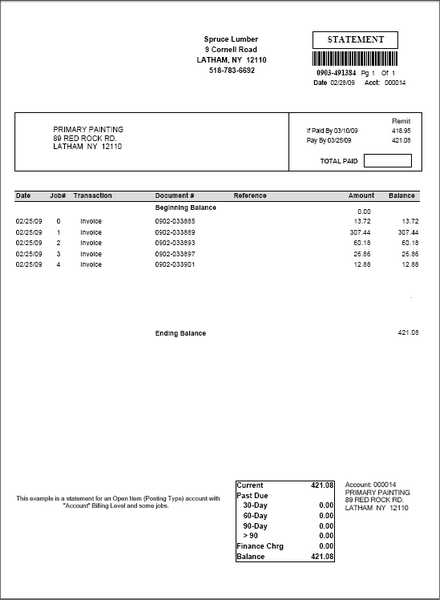Statements - Open Item - Account Billing
This example shows our sample account and activity with the Posting Type of Open Item and Billing Level of Account. Given our determined activity (example), this results in a 4 page statement. In general, this type of account and billing level results in between 1 to 4 printed pages (if no invoice reprints are being done) depending upon activity and whether optional pages are enabled. All optional pages are enabled in the following example.

Page 1 of 4: Summary
The 1st page is a summary of activity listing invoices from the current period. This page is optional. Because this is a "open item" customer, activity listed reflects the payment status of each item. In addition, unpaid transactions from prior billing periods are listed. Notice that there are 2 amount columns on this page: amount and balance. The "amount" column is the original amount of the transaction, the "balance" is the unpaid portion of the original amount.
Page 2 of 4: Statement
Our 2nd page is the main statement. This shows the beginning balance, new activity as a summary by job, and the ending balance. No open credits are listed here (credits that have not been applied, aka. "posted"). The aging of balances for the overall account is printed at the bottom. There is no job-by-job aging with the "account" billing level. The upper portion of the statement is considered a "tear-off" remittance slip. The customer can include this with their payment. The text note to the left of the aging is a "statement message." Statement messages are assigned to codes which are, in turn, assigned to customer accounts. They can be used for any purpose. It's also possible to automatically select a code based upon the customer's oldest balance.
Page 3 and 4: Remittance
Open Item accounts are intended for use with customers who pay by invoice (or "item"). For this reason, these accounts are provided with an optional remittance page listing the open items pending payment as well as any unapplied credits (returns, etc.). The remittance varies in length and is based upon the amount of activity. Due to the number of open invoices, jobs, and the fact that an open credit is included, we wound up with 2 pages in our example.
Optional Pages
For an open item customer to pay by "invoice" or item, they need to know what those items are. Changing the statement type on an Open Item customer to a "No Summary" option actually results in a change in the format of the statement. If the "no summary" choice is selected, the list of open items provided by the activity summary and the balances provided by the statement page are combined together. Choosing a "no remit" option does not affect the format of the 2 remaining pages.
Using our example, the following would replace the 1st two pages of our statement if a "no summary" statement type was chosen.

A Note Regarding Sort Order
As you can see, our customer has 5 jobs, including the master job (0). Job activity can be listed in either Job-Date order or Date-Job order. Sorting depends upon the "statement type" setting (Consolidated vs. Job). This setting affects any activity listing where both jobs and dates are involved (usually the summary and the remittance pages).